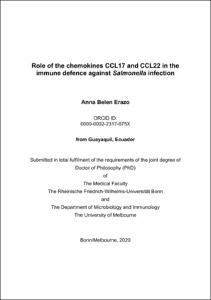Role of the chemokines CCL17 and CCL22 in the immune defence against Salmonella infection

Role of the chemokines CCL17 and CCL22 in the immune defence against Salmonella infection

| dc.contributor.advisor | Kurts, Christian | |
| dc.contributor.author | Erazo, Anna Belen | |
| dc.date.accessioned | 2020-04-27T20:58:15Z | |
| dc.date.available | 2021-04-01T22:00:16Z | |
| dc.date.issued | 17.03.2020 | |
| dc.identifier.uri | https://hdl.handle.net/20.500.11811/8335 | |
| dc.description.abstract | The chemokines CCL17 and CCL22 are both ligands of the chemokine receptor CCR4, which is expressed on dendritic cells (DC) and a variety of different effector T cells including regulatory T cells (Treg). Both chemokines are mainly produced by DC, but also by macrophages. CCL17 promotes numerous inflammatory and allergic diseases, whereas CCL22 is rather associated with an immunosuppressive milieu. These differential roles are reflected by preferential recruitment of distinct subsets of T cells to site of inflammation. While CCL17 facilitates chemotaxis of effector T cells and supports DC-T cell interactions as well as DC migration towards CCR7-ligands, CCL22 induces chemotaxis of Treg cells. In addition, CCL22 signalling induces a more rapid desensitisation and internalisation of CCR4 than CCL17, suggesting biased agonism of CCL17 and CCL22. The functionality of CCL17 and CCL22 should, therefore, be considered in combination as well as individually in the context of immune-related diseases. The role of CCL17 and CCL22 in infectious diseases has not been well understood. The central hypothesis was that CCL17 and CCL22 play important but potentially different roles during bacterial infection. This was modelled using a well-studied bacterial pathogen, Salmonella enterica serovar Typhimurium (STM). It was hypothesised that CCL17 expression may direct the migration of STM-infected DC from the gut to draining lymph nodes a key bottleneck in early infection that controls bacterial dissemination to systemic sites. It was further hypothesised that CCL22 may play a role in immune regulation through the induction of Treg cells. These regulatory cells may have downstream effects on Th1 responses, which are critical for the control of Salmonella infection. In the first part of the thesis, the role of CCL17+ DC in the transmission of STM was investigated. Histological analysis of CCL17 reporter mice revealed that CCL17-expressing cells co-localised with Salmonella in the dome area of Peyer’s patches (PP). Further, CCL17-expressing DC contributed to dissemination of STM from PP to the mesenteric lymph nodes (mLN). Within the mLN, STM were found within CCL17+ DC as well as in other DC, monocytes and macrophages. Analysis of the STM+ DC subpopulations revealed that all DC subsets carried STM, but the CD103+ CD11b- DC could be identified as the main STM-containing population. STM infection triggered upregulation of CCL17 expression in specific intestinal DC subsets in a tissue-specific manner. Interestingly, the CD103+ DC subsets upregulated CCL17 in the PP, whereas CD103- DC subsets upregulated CCL17 in the mLN. In the second part of this thesis, the role of CCL17 and CCL22 in the induction of antigen-specific CD4+ T cell responses was investigated. CCL17/CCLL22 double-deficient, CCL17- and CCL22 single-deficient, and wild type mice were analysed after live-attenuated STM TAS2010 vaccination, vaccination/challenge and in steady-state. Mice deficient in both chemokines, CCL22 and CCL17, demonstrated a reduction of effector Treg cells. This promoted an enhanced STM- specific Th1 immune response characterised by an expansion of Th1 T cells, resulting in a more favourable effector Treg/activated Tconv ratio and a significantly improved vaccine efficacy to challenge with virulent Salmonella. In conclusion, the work presented within this thesis showed the contribution of CCL17+ DC in the dissemination of STM and identified CCL22 as a potential target to improve vaccine approaches. | en |
| dc.language.iso | eng | |
| dc.rights | In Copyright | |
| dc.rights.uri | http://rightsstatements.org/vocab/InC/1.0/ | |
| dc.subject | CCL17 | |
| dc.subject | CCL22 | |
| dc.subject | regulatorische T Zellen | |
| dc.subject | Impfung | |
| dc.subject | DC-Migration | |
| dc.subject | regulatory T cells | |
| dc.subject | vaccination | |
| dc.subject | DC migration | |
| dc.subject.ddc | 500 Naturwissenschaften | |
| dc.title | Role of the chemokines CCL17 and CCL22 in the immune defence against Salmonella infection | |
| dc.type | Dissertation oder Habilitation | |
| dc.publisher.name | Universitäts- und Landesbibliothek Bonn | |
| dc.publisher.location | Bonn | |
| dc.rights.accessRights | openAccess | |
| dc.identifier.urn | https://nbn-resolving.org/urn:nbn:de:hbz:5-57895 | |
| ulbbn.pubtype | Erstveröffentlichung | |
| ulbbnediss.affiliation.name | Rheinische Friedrich-Wilhelms-Universität Bonn | |
| ulbbnediss.affiliation.location | Bonn | |
| ulbbnediss.affiliation.otherLocation1 | Melbourne | |
| ulbbnediss.affiliation.otherName1 | University of Melbourne | |
| ulbbnediss.thesis.level | Dissertation | |
| ulbbnediss.dissID | 5789 | |
| ulbbnediss.date.accepted | 03.03.2020 | |
| ulbbnediss.institute | Mathematisch-Naturwissenschaftliche Fakultät : Fachgruppe Molekulare Biomedizin / Life & Medical Sciences-Institut (LIMES) | |
| ulbbnediss.fakultaet | Medizinische Fakultät | |
| dc.contributor.coReferee | Förster, Irmgard | |
| ulbbnediss.contributor.orcid | https://orcid.org/0000-0002-2317-675X | |
| ulbbnediss.date.embargoEndDate | 01.04.2021 |
Dateien zu dieser Ressource
Das Dokument erscheint in:
-
E-Dissertationen (1581)




